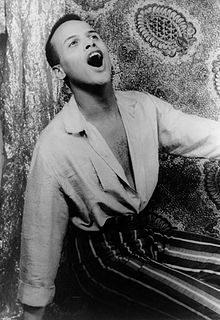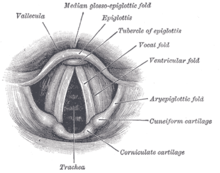Singing
![]()
This article is about human singing. For other meanings, see Song (disambiguation).
![]()
Singer is a redirect to this article. See also: The singer.
Singing is the musical use of the human voice and probably the oldest and most original form of human musical expression. Singing exists in very different forms, from spontaneous, improvised singing of single notes or tone sequences to folk songs, art songs, virtuosically ornamented art singing (bel canto) as well as monophonic, homophonic and polyphonic choral music. Singing is of outstanding importance for music because it combines music and speech and makes use of the emotional expressiveness of the human voice. A distinction is made between purely vocal music (e.g. a cappella choral music) and instrumental music and combined forms (e.g. cantata, oratorio, opera).
The term singing, by definition, includes all forms of musical voice use, but some forms must be distinguished from ordinary singing. Singers are therefore exclusively persons who hold and hit notes during their singing, and thus the forms of singing to which this characteristic applies are called singing and the forms to which it does not apply are not. Thus, in addition to singers, there are also artists who do not meet this criterion, such as beatboxers, who merely produce short rhythmic sounds through the voice, or also spoken-song artists (e.g.: rappers or toasters), who perform spoken texts in a musical manner.
In contrast to speaking, singing uses specific pitches within the framework of a given tonal system, and singing is usually organized metrically and rhythmically throughout. For professional singers, sufficient voice training, coordination of the vocal registers and breath control adapted to the musical phrases play a major role.

Harry Belafonte (Feb. 1954)
Generation of the singing voice
Singing involves the same organs as speaking: Diaphragm, lungs, the vocal folds with the vocal cords in the larynx and the vocal tract above the larynx. As in speech, the voice is produced in particular by the vibrating vocal cords, and the sound is formed primarily in the vocal tract. Numerous muscles cause a changing tension of the vocal folds.
The length of the vocal cords and their vibration behaviour are primarily responsible for the pitch of the voice. Children initially have a very high voice, which decreases as the vocal cords grow. This growth is much more pronounced in boys than in girls and a voice change marks the strongest growth phase.
Until the 18th century, and occasionally even until the beginning of the 20th century, there were castrati who retained their childlike high voice through an operation or mutilation, but had to pay for this with the loss of their procreative ability. Today, men with specially trained falsetto sing in comparable voice ranges as countertenors, altos, or sopranos. The faithful alternative of using boys' voices is also practised.
Singing with closed lips is called humming. The air is thereby completely discharged through the nose, which causes only a very small amount of air to vibrate.
The functioning of the human singing voice can be compared in a very simplified way with the padded pipes (cf. wind instruments and sound); the pads correspond to the two vocal folds, which are located opposite each other between the thyroid cartilage and two movable cartilages (which, together with the cricoid cartilage and the epiglottis, form the laryngeal skeleton) and are stretched out slightly inclined upwards towards each other.

Glottis and vocal cords
Voice training and singing lessons
Vocal pedagogy in European culture deals with the development of a voice suitable for musical use. Professional training as a professional singer in the field of classical music, jazz or pop takes place in Germany at music colleges or in private studios. The academic training lasts at least eight semesters. Sub-areas of the singing lessons are:
- Bodywork with different methods such as gymnastics, Feldenkrais method, Alexander technique, yoga
- Voice training
- Interpretation
The training for opera stage, jazz, pop music and musical differs fundamentally in the styles, but also partly in the applied vocal technique. Classical vocal training is often oriented towards the practice of bel canto. In some works of contemporary vocal music, however, the entire tonal range of the human voice is employed. At some universities there is an advanced course of study for this. In training for pop or musical singing, the belting technique is often used, among other things.
Rock and metal singers are often self-taught without classical vocal training. In the professional field, however, singing lessons are also taken in this genre to prevent vocal damage.
Questions and Answers
Q: What is singing?
A: Singing is a way of making music with the voice.
Q: How long ago did music probably start with singing?
A: Many thousands of years ago.
Q: How do people make their voices go high or low when singing?
A: By using their vocal range.
Q: What do people create when they sing in a way that uses notes of a musical scale?
A: Tunes or songs.
Q: How is a song defined?
A: A song is a musical piece produced by the voice with distinct and fixed pitches and patterns of sound and silence which often includes repetition.
Q: What are passerines?
A: Passerines are a very large order of birds, often called songbirds, that also sing.
Q: What do birds and people have in common in terms of singing?
A: Both birds and people can sing, making music with their voices by using distinct and fixed pitches and patterns of sound and silence.
Search within the encyclopedia